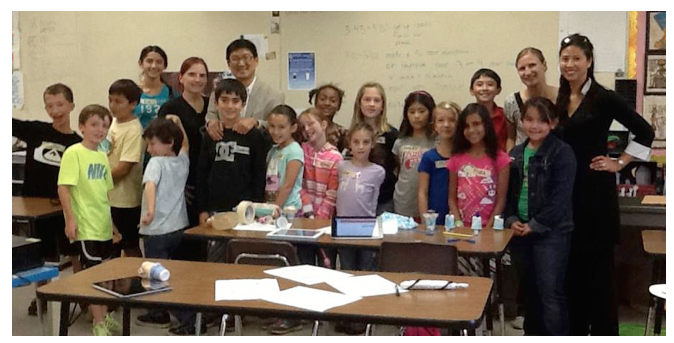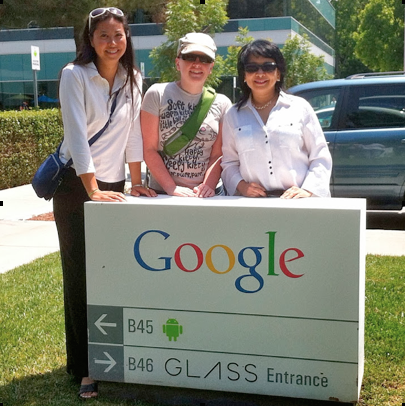Students with Professor Kim, the assistant dean and chief technology officer of Stanford University’s Office of Innovation & Technology and SMILE’s creator. Students SMILE while they tinker through this hands-on design thinking workshop series.
beginning of article
Teachers Promote Risky Behavior to Develop Creative Mindsets
By Mira Gillet
A small after school program in the Bay Area, Workshop Education, is burgeoning into a design group with guests from around the world coming to see this group in action.
Rebecca Crook visited from South Africa, where she is Academic Dean at SPARK schools, a new network of low-fee private schools in Johannesburg. “When we asked her how long it took to get here, she said it took 31 hours,” one of the Workshop students said.
The Workshop students in grades 3-8 at Northstar Academy, a charter school in Redwood City, wanted to design something for Ms. Crook. She said she needed a way to help her students celebrate the life of Nelson Mandela when she returned to school. After learning more about her problem and brainstorming, the students came up with a prototype. They would record their thoughts about Mandela in a booklet for her to share with her students so they would know how much Mandela meant to people all around the world.
“Thank you so much for meeting with me to speak about Workshop and Design Thinking. I appreciated and thoroughly enjoyed seeing your program in action! I was especially impressed by the fact that your students are able to fluidly move through and lead others in the design process. I kept the Nelson Mandela booklet and cell phone finder prototypes as inspiration as I further develop a child-centered curriculum. Thank you again for letting me experience Workshop!” said Rebecca Crook.
Rebecca is back in South Africa now, but since Workshop showed her how to use SMILE, the Workshop students can still learn from her and she can still learn from the students in California.
SMILE, the Stanford Mobile Inquiry Learning Environment, is a learning management system that allows students to create, share, answer, and evaluate higher order thinking questions in a collaborative manner through the use of mobile technology.
Mira Gillet, the Director of Design Thinking for Workshop Education and Lead Field officer of the SMILE pilot through Workshop, and her students were excited to have Professor Kim, the assistant dean and chief technology officer of Stanford University’s Office of Innovation & Technology and SMILE’s creator visit to learn more about how the students used SMILE. “The students wanted to interact, show their inventions, share their inquiry learning, compare their analytical thinking, and have fun with video recording and hands-on making,” said Ms. Gillet.
SMILE research team: Mira Gillet, Alison Burek, Roz Hussin, under Professor Paul Kim, CTO and Assistant Dean, Stanford University Graduate School of Education. Ms. Gillet’s other projects are PEACE GAME online, top voted learning game through Designing a New Learning Environment and Design Out of the Box to spread design thinking to all.
Through hands-on tinkering and experimenting, students explore design thinking by repurposing recycled electronic devices to create prototypes of their design ideas. They also practice their research and inquiry learning skills through the SMILE platform.
Working on iPads and other mobile devices, they learn to inspect, inquire, seek, analyze, formulate and answer questions that they are curious about during the design process. Each student, working in pairs, teams or independently, generates his/her own questions and competes to see who can create the highest-rated question and who can answer the most questions correctly.
This inquiry based creativity experience empowers every student to engage at their own pace, gain proficiency in mobile technology, exercise their imagination, and realize their skills.
Because Workshop takes risks and advantage of free learning applications, they also experienced 21st century learning using the Google Hangout with Roz Hussin, a Stanford Research Associate and Instructional Design Technology Specialist working on SMILE with Ms. Gillet. Originally from Maylasia, Roz taught Workshop students remotely from Nebraska using Google Hangout that incorporates photos and slides into a video call.
As research colleagues, the two are collecting material that may be used for a future online SMILE certification course for teachers.
Ms. Hussin walked Workshop through slides showing the overview of the week’s theme – how to solve the water crisis in developing countries. After that, the kids designed water filters. Before Ms. Hussin’s presentation, the kids didn’t know there was a water problem in Africa. After taking risks and designing water filters of their own, kids researched and created their own questions for SMILE, such as “How do sand filters work?” and “How can I get my water filter prototype to work?
These Amazing Kids
The diversity of this Workshop Education group reflects the diversity of Silicon Valley. Students come from Latino, Iranian, Filipino backgrounds and a wide range of economic circumstances. Most importantly, these kids are not afraid to take appropriate risks to experiment in order to design products and processes to change the world. They gain creative confident by practicing Stanford Design School’s Methodology.
This combination of design thinking and inquiry learning is “hands on” which turns minds on.
“Jacob Guernsey is working on his MBA in Design Strategy at San Francisco’s California College of Arts (CCA) which BusinessWeek magazine rates as one of the world’s best design schools. He visited Workshop and said, “I was amazed that the kids are learning the same thing I am in my Masters Program.”
The pedagogical model that has been developed involves four-parts:
(1) Design Thinking – Kids are given a problem to solve (or a theme around which they define a problem); They then embark in creative hands-on “making” or “tinkering” (or taking apart an existing designed object). The end product is a prototype of their design solution.
(2) Inquiry Learning – Kids create questions based on what they have discovered/created in the design thinking phase. They can write the questions on paper first, or directly input into the SMILE platform, depending on availability of devices.
(3) Analytical Thinking – Kids answer questions created by peers and evaluate those questions based on a given rubrics (scale of 1-5 stars: a “good” question is one that provokes you to think further and ask more questions). This part is carried out on the SMILE platform.
(4) Reflection + Metacognition – Kids interview each other and document their thoughts in all three processes. This is documented through video recording, drawing diagrams, and sharing with others. The teacher’s role is to facilitate the recollection and acknowledge key points presented by the kids.
Ms. Gillet has observed a variety of outcomes from this strategic approach — some positive (which SMILE will want to replicate and scale), plus a few challenges (which are suggestions for SMILE platform design improvements). Since this combination of design thinking with inquiry learning is dynamic, there are some of the on-the-ground challenges. The team is extremely flexible and changes to the needs of the students.
Workshop Education
Workshop Education is unique because it combines constructivism and connectivism theories together. Students design products, processes, and questions that lead to innovation to strengthen their 21st century skills.
Workshop Education, a unique model for after school enrichment, was created by Alexa Frisbie in 2009. Ms. Frisbie, an educator and a parent, created Workshop when she couldn’t find a program that combined innovative enrichment with scheduling flexibility. “We are so close to such amazing learning opportunities, the d.School at Stanford, Bay Area Writing Project in Berkeley, innovation in Silicon Valley, artists in San Francisco, and I wanted to connect students to these vibrant real life learning experiences. The program has expanded to five schools in Hillsborough, Redwood City, and Montara, CA. Workshops are offered daily from school dismissal until 5:30, and parents choose enrichment Workshops that work for their schedule.
During Design Thinking Workshops, students design solutions for their classmates, families, or the world. One boy created this solution to making mornings better with him mom.
Come to workshop and we will design something important to you. It will make you SMILE.
Another group took on a project of designing a product to help the blind.
“Empathy is a huge piece of learning design thinking. You have to deeply understand a situation before you can create a product or process to improve it. Children are often in a position where they are mainly consuming other people’s creations via iPad, iPhone, video games, and television. Workshop is a little oasis where we expect children to be a part of the learning and growing process,” said Ms. Frisbie.
Or as one student at Workshop said, “I have never had the chance to build my ideas before.
Connecting with fellow innovators, Workshop and SMILE are making sure that more children get that opportunity.

